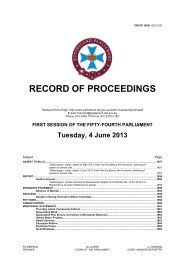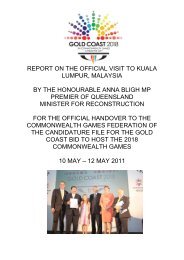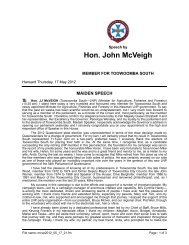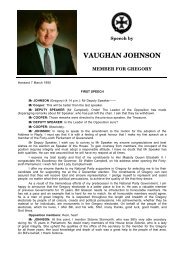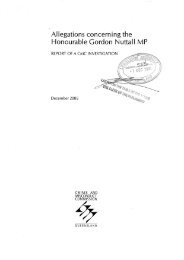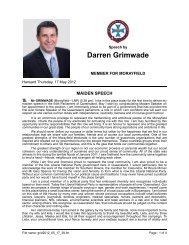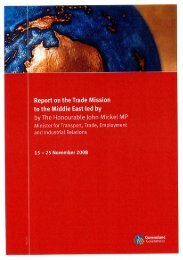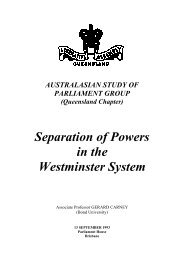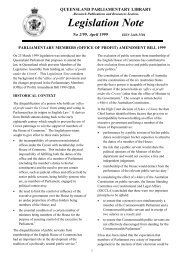RECORD OF PROCEEDINGS - Queensland Parliament ...
RECORD OF PROCEEDINGS - Queensland Parliament ...
RECORD OF PROCEEDINGS - Queensland Parliament ...
Create successful ePaper yourself
Turn your PDF publications into a flip-book with our unique Google optimized e-Paper software.
22 May 2013 Questions Without Notice 1673<br />
Recently my department has undertaken—and prior to us coming into office under the previous<br />
government—a review of the sustainability of funding to community based helicopter rescue services<br />
in <strong>Queensland</strong>. I was not very happy with the way in which that review had been established and<br />
recently brought in some consultants to finalise that. In our discussions with the community based<br />
helicopter rescue services throughout <strong>Queensland</strong> we are now getting a large and significant<br />
consensus of view with regard to a new funding model going forward. Many of those helicopter<br />
rescue services provide an extraordinarily good job to <strong>Queensland</strong> and, obviously, we need to ensure<br />
that we have sustainability in their base funding and also appropriateness with regard to the overfly<br />
hours, which they do as well. Many of those do hundreds and hundreds of hours.<br />
I know the honourable member may be disappointed with this answer. However, it is not<br />
beholden to the department of health in <strong>Queensland</strong> to step in and provide block funding to a<br />
helicopter service that establishes themselves under the guise of being a rescue helicopter service. In<br />
2011, this service was recognised as being able to do ad hoc work for the department of health.<br />
Indeed, I understand since about July last year they have been contracted to undertake about nine fly<br />
hours, equivalent to around about $30,000 to $35,000. That decision has been made by local<br />
clinicians. Also, recently we have seen the withdrawal of funding available to that particular provider in<br />
north-west <strong>Queensland</strong> by one of their benefactors—a sponsor. I think the honourable member needs<br />
to consider how these services should be established. It is not the role of the state to step in and just<br />
bail them out.<br />
(Time expired)<br />
Flood Recovery<br />
Mr BENNETT: My question without notice is to the Minister for Local Government, Community<br />
Recovery and Resilience. Will the minister please provide the House with an update on the flood<br />
recovery and explain how the government is increasing resilience with a limited amount of money?<br />
Mr CRISAFULLI: Can I start by acknowledging the local member and indeed the role he has<br />
played in the hour of need for his community. He has been magnificent, as has the police minister, in<br />
their part of the world.<br />
The question was in two parts, but let me start by speaking about the recovery effort. The<br />
member asked how the recovery effort is going. The answer is that it is going very well. I have to pay<br />
tribute to those local governments—not just Bundaberg and North Burnett but right across the state—<br />
that have rolled up their sleeves in a way that I have never seen before. The attitude from local<br />
government to want to get on and make this work has been wonderful.<br />
I also acknowledge the work of the <strong>Queensland</strong> Reconstruction Authority. Gone are the days of<br />
the paper warfare that existed where a council would put in an application and then it would be<br />
assessed and then the QRA would come back and say, ‘No, maybe, maybe this way, maybe that<br />
way’ and then it would go back and forward. This time the Reconstruction Authority has been on the<br />
ground from day one and the argy-bargy that we have seen in years gone by has happened from day<br />
one rather than a trail of paper that is taking months. Of all the statistics that I can give there is one in<br />
my mind that crystallises how this recovery effort is going compared to the last one. In 2011, it took<br />
the Bundaberg council 18 months to get $25 million worth of work to market. In 2014, it has taken four<br />
months to get $40 million of work to market. If ever you need proof of what happens when two levels<br />
of government work together, it is that on the ground.<br />
I acknowledge that there has been a huge social impact as well and the uncertainty and the<br />
fear in some communities as I have walked the streets in places like Mundubbera is very real. In<br />
places like Gympie, where businesses have flooded five times in two years, it is real. It is against that<br />
backdrop that I have discussed the need not just to replace like for like but to look at mitigation and to<br />
look at betterment. Whilst the fund that we have been able to secure for betterment is much less than<br />
we would have liked, today I can announce a further three projects to be funded out of that betterment<br />
fund for the Bundaberg Regional Council. They are for three projects in the member’s electorate and<br />
three projects that he knows all too well. In fact, I have even inspected one with him. They are Gentle<br />
Annie Bridge, Barretts Road, and Blacks Road. In all cases, for a small investment upfront we can<br />
prevent what we have seen, which is over and over going back and doing the same culverts, the<br />
same bridges. In all cases it has prevented the community from going about their daily lives—from<br />
getting medical treatment, from going to school, from doing all of the things that we take for granted.<br />
So $80 million may not be what we were chasing, but it is my great desire and my intention to make<br />
sure that we deliver huge value for money and show that there is a better way with disaster recovery.



